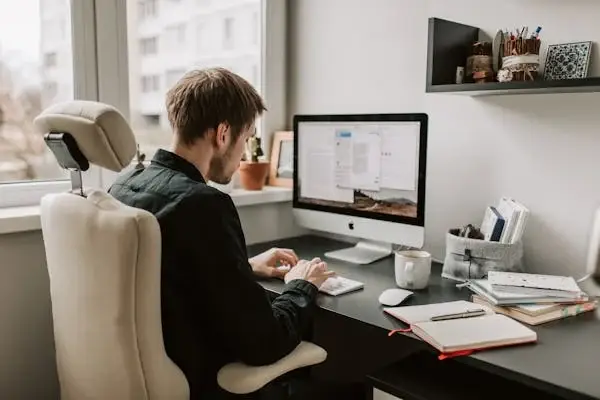How Ergonomics Prevent Back Pain: 7 Tips For Back Pain-Free Home Working
Why Does Ergonomics Matter For Your Back
What is Ergonomics?
How Back Pain Develops
Common Causes of Back Pain While Working from Home
Poor Posture and Sitting Habits
Lack of Appropriate Furniture and Work Environment
No Development and Stagnation
How Ergonomics Can Cure Back Pain Or Lower Back Pain
Proper Chair and Desk Setup
Setting up your workspace is one of the most important things to help prevent back pain while working from home. A healthy desk and chair setup is comfortable and means your body can stay aligned throughout the day, taking the pressure off your back. Here are the elements of an ergonomic setup to help you avoid back pain:
Chair Height and Lumbar Support

Desk Height and Angle
Posture Adjustments
While optimizing your furniture setup is essential, one of the best ways to avoid back pain while working from home is to adjust your posture throughout the day. Using the most ergonomic chair and desk, lousy posture can still add strain and discomfort in the back. Good posture is essential for maintaining the alignment of your spine and minimizing muscle tension. Follow these tips to keep your posture optimal throughout your day:
Keeping the Spine Aligned
To avoid pain in your back while working from home, it’s essential to maintain the proper alignment of your spine during the day. First, sit in your chair and slide back so the backrest supports your spine. This keeps your spine’s natural curve, reducing strain on your muscles and ligaments. Don’t lean your body forward since that can throw you out of alignment and strain your spine, especially in the lower back.
Adjusting your posture intentionally and ensuring your spine is aligned is a critical step in how ergonomics can prevent back pain while working from home. This small change reduces stress on your joints, promotes comfort, and protects your spine from long-term damage.
Foot Position and Leg Support
The third thing about computer work to stop back pain is proper foot position and leg support. Your feet should touch the floor, your thighs probably parallel to it. This position helps ensure your body stays neutral and well-supported, reducing tension on your lumbar spine and pelvis. Proper articulation of your legs relieves the pressure on the spine, so the load on the spine is distributed more evenly, reducing the risk of muscle fatigue and discomfort.
If your feet don’t touch the floor because of the height of your chair or the configuration of your desk, get a footrest to ensure that your legs are in alignment. A footrest lets you keep your legs at a comfortable angle, keeping your knees from being higher than your hips, a position that can add to lower back pain. Insufficient support for your legs increases the tension in your lower back and pelvis, resulting in discomfort and stiffness.
When Movement Becomes a Habit
Ergonomic Tools and Accessories for Home Offices

Ergonomic Chairs
Standing Desks and Adjustable Desks
Typing and Footrest Adjustments
Ergonomics Benefits in the Long Run for Back Health

Lessening the Risk for Chronic Pain
Increased Comfort and Productivity
Conclusion
FAQ Section
1.How do I know if my desk setup is responsible for back pain?
That alone may reduce signs of trouble: discomfort after long periods of sitting, stiffness in your lower back, and recurring tension headaches. You may want to adjust if your furniture encourages you to slouch or hunch over.
2.How much time should I spend working without breaks to prevent back pain?
Try to take a mini-break every 30 to 60 minutes. Stand up, stretch, or walk around to take some pressure off your spine and muscles.
3.Should I consider a standing desk to avoid back pain?
Yes! Switching between sitting and standing can help mitigate strain on your back and increase circulation, decreasing your chances of experiencing back pain.
4.Is sitting at my desk for prolonged periods bad for my back?
Remaining seated for prolonged hours can lead to stiff muscles and backaches. Good posture and periodic breaks every 30 minutes are essential to stay active.
5.Which chair is best to avoid strain?
This extra strain causes muscle-fit imbalances and pain because poor posture puts additional strain on your spine, muscles, and ligaments. Keeping a neutral spine relieves pressure on those places.
6.How does bad posture cause back pain?
This extra strain causes muscle-fit imbalances and pain because poor posture puts additional strain on your spine, muscles, and ligaments. Keeping a neutral spine relieves pressure on those places.
7.Will ergonomic accessories like a footrest or keyboard tray help with back pain?
Yes! Those attachments play an element in adequately aligning your body and relieving stress on your back, shoulders, and neck.
8.What stretches can I do to relieve lower back pain at home?


